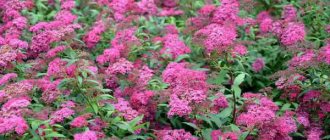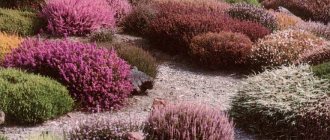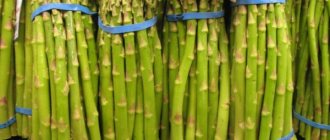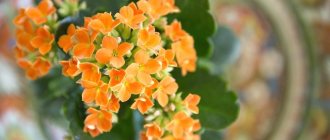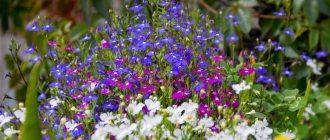Types and varieties of plants, appearance
The small shrub Japanese quince has other names: chaenomeles and low quince. The height can reach about 1 m. It has curved arched branches and densely packed small leaves of a bright green hue with jagged edges. Hybrid quince varieties have thorns and some have completely bare branches.
Garden quince flowers can have different shades: red-orange, white, pink. The Japanese quince bush, a photo of which is in the article, has a very powerful root in the form of a rod. Bush quince produces green-yellow or bright orange fruits. They are covered with a wax-like coating.
The plant has many varieties, let’s look at the most popular ones:
- Quince is magnificent, or Crimson and Gold. Shrub up to 1.2 m high with dark red inflorescence.
- Simoni. It has crimson-red flowers and completely green fruits.
- Holland. A shrub with bright green leaves and orange-red flowers.
- Nivalis. Blooms with white buds. It has yellow round fruits.
- Pink lady. It has beautiful leaves and pink flowers. Height no more than 1.5 m.
- Vesuvius. It has a wide crown with many red inflorescences.
- Jet Trail. Decorative quince with creeping branches with white flowers.
What is Japanese quince?
Small deciduous trees or shrubs belonging to the genus Chaenomeles of the Rosaceae family. Wild representatives are found in China and Japan. In Europe and North America, these plants have been known for more than two hundred years due to the magnificent flowering and ability of Chaenomeles to form dense natural borders. In the Soviet Union, Japanese quince under the name quince became widespread in the Baltic states, especially in Latvia.
By mistake, chaenomeles seeds were sent to Latvia instead of ordinary quince (lat. Cydonia) seeds. For a long time it was cultivated there as quince, although the misunderstanding was quickly cleared up. The properties of the fruit were studied and it was determined that the content of vitamin C, carotene, B vitamins and organic acids was superior to lemon. This is where another common name for Chaenomeles comes from - Northern lemon.
The shoots of most varieties have thorns, which provide plantings with a protective function.
Thorns on the shoots cause a lot of trouble when harvesting
The height of the bushes, depending on the place of growth, ranges from one to six meters. There are creeping forms. In Russia it rarely grows more than one and a half to two meters. The trunk and branches are usually brown, sometimes with a reddish tint. The shoots are covered with thorns. The glossy leaves of Chaenomeles are round, ovoid-oval or lanceolate in shape. They have jagged or serrated edges.
Chaenomeles leaves are round, ovoid or oval
The flowers, magnificent in color and appearance, attract bees with their subtle aroma. The color of the petals differs among different varieties. There are white, soft pink, orange and red. The shape is simple or terry. A simple flower has five petals, from twenty to fifty bright, thin stamens and a pistil consisting of five fused pistils. Flowering of Chaenomeles is usually observed in April-May.
Photo gallery: Chaenomeles blooming
Colorful flowering and compact bushes have led to the use of Japanese quince in landscape design. Chaenomeles looks great next to other plants, in single plantings and as a border.
Photo gallery: Japanese quince in landscape design
Despite the fact that the plant was known and actively used in the formation of gardens, the valuable properties of the fruit were not known. The small fruits of Chaenomeles are shaped like an apple or quince. The color is lemon yellow, orange or yellow with blush.
Chaenomeles fruits are a valuable raw material for the food, pharmaceutical and perfume industries due to their rich chemical composition. They contain biologically active substances (ascorbic acid, carotene, B vitamins), organic (malic, citric, tartaric, fumaric, chlorogenic, quinic) and aromatic (caffeic, coumaric isomers) acids, pectic, phenolic, mineral substances, carbohydrates, fatty oils
V. P. Petrova
Wild fruits and berries. – M.: Forest Industry, 1987. – P. 172–175
The average weight of the fruit, depending on the variety and growing conditions, ranges from 30–40 to 150–300 grams. The surface is oily. The pulp is very dense, sour, has a sharp citrus aroma and contains a large amount of pectin. The seed chambers contain many small brown seeds.
Chaenomeles fruits are very aromatic, but sour in taste.
Chaenomeles fruits ripen at the end of September or October.
Almost no variety of Japanese quince ripens completely in the conditions of central Russia. But the peculiarity of this plant is that the fruits can be collected unripe; the amount of ascorbic acid does not decrease after harvesting the fruits, and, according to some information, even increases during storage.
Due to its sour taste and dense pulp, chaenomeles is not used for food in its raw form. Japanese quince is used in the preparation of compotes, jams, and confitures.
I suffered for a long time preparing quince fruits. The dense flesh did not give in to the knife and resisted as best it could. The process of processing aromatic quince more and more resembled sophisticated torture, until a friend suggested a simple and easy way to prepare confiture. The washed ripe chaenomeles fruits should be placed in an enamel pan, pour a small amount of boiling water, cover with a lid and put on fire. A few minutes after boiling, the pulp becomes soft. The contents of the pan are cooled and passed through a colander. The seed chambers are easily separated, and a thick, aromatic confiture jelly is ready. Sugar is added to taste. If desired, chaenomeles is combined with an apple, pear or plum.
Northern lemon, unlike its heat-loving namesake, is an unpretentious plant. It is not demanding on the composition of the soil and grows even on poor lands. It has good winter hardiness. Typically, representatives of this genus have deep and branched roots, due to which they are able to tolerate drought. Practically not damaged by pests. There are rare mentions of damage by aphids and gall midges.
Video: about growing Japanese quince
Where and how does it grow
Japanese quince, a shrub whose photo you see in the article, is a heat-loving plant and grows well in regions with warm climates. Despite its heat-loving nature, quince can withstand frost. Quince blooms magnificently from May to June. Quince prefers soil rich in humus.
The shrub begins to bear fruit from the 3-4th year of life. On average it ripens at the end of September or October.
Application
In cooking
Wonderful jam, syrup, jelly and liqueur are prepared from the aromatic fruits of Japanese quince. You can make compotes from dried fruits. You can also prepare sweet pastries with the addition of quince. But in addition to sweet products, many meat dishes are prepared with quince.
In medicine
This fruit crop is widely used in folk medicine. The juice of ripe fruits has an anti-inflammatory, immunomodulatory and diuretic effect on the body. Also, quince fruits are considered effective antioxidant and hemostatic, choleretic and diuretic agents.
When losing weight
Quince is a fairly low-calorie product, but it quickly saturates the body without harming the figure. Also in dietary nutrition, the fruit is used to prepare decoctions and teas. Quince is also useful to eat baked.
At home
Gardeners use Japanese quince as an ornamental shrub. It will perfectly decorate the garden and terrace.
In cosmetology
Quince fruits are used to make lotions, masks and decoctions. The vitamins and amino acids contained in quince significantly improve the condition of hair and skin.
Reproduction of Japanese quince
Chaenomeles can be propagated vegetatively and by seeds (generatively). During vegetative propagation, Chaenomeles retains the varietal characteristics of the mother plant. But obtaining seedlings from your own seeds is also important. They are more adapted to local conditions, have new properties that are different from the parent ones, which are used for breeding, and can be used as a rootstock.
Vegetative propagation of Chaenomeles
- cuttings
- root shoots,
- layering,
- dividing the bush.
All these methods are quite simple.
Cuttings
For cuttings, in the first half of summer, stem cuttings 20–25 cm long are cut. Both young and mature cuttings take root equally well.
To obtain cuttings:
- Cut off woody or green shoots.
- The apical bud is removed.
- Depending on the length of the shoot, one or more cuttings are prepared.
- Planted in the ground at an angle so that at least two buds are underground.
They are planted in small greenhouses for rooting, after which they are planted in a permanent place.
Another method is more familiar to me. I plant the cuttings in fertilized soil to a depth of 10–15 cm at an angle of 45° to the surface of the earth. I water it. I close the top with a three-liter jar. I try not to touch the jar until sprouts appear in order to maintain high humidity. By autumn the young plant is ready. I mulch it with humus and cover it for the winter.
Propagation of Chaenomeles by stem cuttings
Reproduction by root suckers
The root offspring is separated from the mother bush and transplanted to the desired location. The method is not difficult even for novice gardeners.
Nutritional value and chemical composition
The fruit has high nutritional value. 100 g of fruit pulp contains approximately 48 kcal. Also, 100 g of quince contains:
- proteins – 0.4 g;
- fats – 0.1 g;
- carbohydrates – 15.3 g;
- water – 83.8 g;
- ash – 0.4 g.
The composition of quince includes vitamins A, B, C, E, PP. It also contains useful microelements: calcium, zinc, iron, copper, sodium, potassium, selenium, phosphorus.
How to grow, care, pests and diseases
This variety of quince should be planted in well-lit areas in the spring. Potassium nitrate, superphosphate, ash and a couple of buckets of humus are poured into the hole for the seedling. After planting, the plant needs to be watered frequently. You also need to fertilize the plant in time and prune it. Japanese quince, a shrub that must be pruned, should not have more than 20 branches at a time. The Japanese quince shrub, planting and caring for which does not require much effort, is propagated by cuttings and grafting.
The most common pest for quince is aphids. To combat it you need to use special means. In wet weather, quince can suffer from fungal diseases. To combat them, use copper-soap liquid or foundationazole.
Planting Japanese quince
Chaenomeles is not very picky. The only condition that must be met when planting Japanese quince seedlings is lighting. In the shade the plant bears fruit worse.
For chaenomeles, choose sunny, bright areas protected from the north wind. You can plant in both spring and autumn. Seedlings are usually planted in a continuous trench at a distance of 90–100 cm, but single plantings are also used. Pit depth 40 cm, width 50 cm. Optimal soil acidity: pH 5.0–5.5. The bushes also grow on clay soils, so the planting holes are not always drained, but it has been noticed that adding humus in a 1:1 ratio leads to an increase in the size of the fruit.
Some gardeners recommend shortening the roots of seedlings by 20–40 cm before planting and treating them with a clay mash. Others believe that there is no need to trim them, but rather dust them with Kornevin to avoid stress during planting. These recommendations apply only to bare-root plants. Containerized seedlings have minimal stress during planting.
- Dig a hole 50x50x40 cm.
- Mix humus with soil in a 1:1 ratio.
- Plant the bush without deepening the root collar.
- They fill the soil, compacting it tightly and forming a watering hole.
- Water the tree trunk abundantly and mulch it.
Immediately after planting, the bush is pruned to a height of 20–25 cm.
Mulching the tree trunk emphasizes the beauty of the bush, retains moisture and prevents weeds from growing
